A critical topic in cloud-native applications is the deployment strategy. We are no longer dealing with one monolithic application. We have several applications that have dependencies on each other and also have other dependencies like brokers or databases.
Applications have their own life cycle, so we should be able to execute independent blue/green deployment. All the applications and dependencies will not change their version at the same time.
Another important topic in the cloud-native space is continuous delivery. If we are going to have several applications doing blue/green deployment independently, we have to automate it. We will use Helm, Argo Rollouts, Red Hat OpenShift GitOps, and, of course, Red Hat OpenShift to help us.
Argo Rollouts is a Kubernetes controller and set of Custom Resource Definitions (CRDs) that provide advanced deployment capabilities such as blue-green, canary, canary analysis, experimentation, and progressive delivery features to Kubernetes. In this demo, we are going to use blue-green capabilities.
In the next steps, we will see a real example of how to install, deploy, and manage the life cycle of cloud-native applications doing blue/green deployment using Argo Rollouts.
If you want to know more about blue/green deployment, read Blue/green deployment strategy with OpenShift Pipelines.
Let's start with some theory; after that, we will have a hands-on example.
Shop application
We are going to use very simple applications to test blue/green deployment. We have created two Quarkus applications, Products and Discounts. Figure 1 shows the Shop applications.
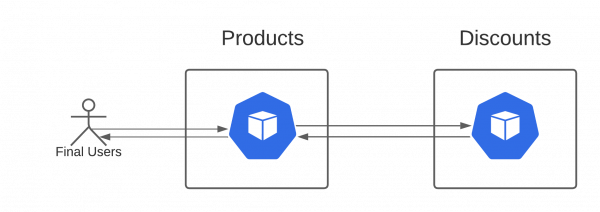
Products call Discounts to get the product's discount and expose an API with a list of products with its discounts.
Shop blue/green
To achieve blue/green deployment with cloud-native applications using Argo Rollouts, we have designed this architecture, which you can see in Figure 2.
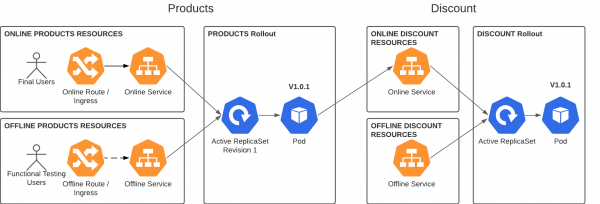
OpenShift Components - Online:
- Routes and Services declared with the suffix
-online - Routes mapped only to the online services
- Services mapped to the rollout.
OpenShift Components - Offline:
- Routes and Services declared with the suffix
-offline - Routes mapped only to the offline services
- Services mapped to the rollout
This is an example of products rollout manifest:
strategy:
blueGreen:
activeService: products-umbrella-online
previewService: products-umbrella-offline
autoPromotionEnabled: false
prePromotionAnalysis:
templates:
- templateName: products-analysis-template
We have defined an active or online service, products-umbrella-online, and a preview or offline service products-umbrella-offline. Final user will always use products-umbrella-online. We have created an AnalysisTemplate, products-analysis-template, that just validates the health of the application, for production environments a better analysis should be done. Argo Rollouts use this AnalysisTemplate to validate a new version and set it ready to be promoted or not. To learn more, read BlueGreen Deployment Strategy.
Shop Umbrella Helm chart
One of the best ways to package Cloud Native applications is Helm. In blue/green deployment it makes even more sense. We have created a chart for each application that knows nothing about blue/green. Then we pack everything together in an umbrella helm chart that you can see in Figure 3.

In the Shop Umbrella Chart we use several times the same charts as helm dependencies but with different names if they are online/offline. This will allow us to have different configurations for each color.
We have packaged both applications in one chart, but we may have different umbrella charts per application.
Demo
Prerequisites:
- Red Hat OpenShift 4.13 with admin rights.
- Git
- GitHub account
- oc 4.13 command-line interface (CLI)
- Argo Rollouts CLI
We have a GitHub repository for this demo. As part of the demo, you will have to make some changes and commits. So it is important that you fork the repository and clone it in your local:
git clone https://github.com/your_user/cloud-native-deployment-strategies
If we want to have a cloud-native deployment, we cannot forget CI/CD. Red Hat OpenShift GitOps will help us.
Install OpenShift GitOps
Go to the folder where you have cloned your forked repository and create a new branch called rollouts.
git checkout -b rollouts
git push origin rollouts
Log in to OpenShift as a cluster admin and install the OpenShift GitOps operator with the following command. This might take a few minutes.
oc apply -f gitops/gitops-operator.yaml
Once OpenShift GitOps is installed, an instance of Argo CD is automatically installed on the cluster in the openshift-gitops namespace and a link to this instance is added to the application launcher in OpenShift Web Console.
Log in to the Argo CD dashboard
Argo CD upon installation generates an initial admin password which is stored in a Kubernetes secret. In order to retrieve this password, run the following command to decrypt the admin password:
oc extract secret/openshift-gitops-cluster -n openshift-gitops --to=-
Click on Argo CD from the OpenShift Web Console application launcher and then log into Argo CD with admin username and the password retrieved from the previous step.
Configure OpenShift with Argo CD
We are going to follow, as much as we can, a GitOps methodology in this demo. So we will have everything in our Git repository and use Argo CD to deploy it in the cluster.
In the current Git repository, the gitops/cluster-config directory contains OpenShift cluster configurations such as:
- namespaces
gitops. - role binding for Argo CD to the namespace
gitops. -
namespaces argo-rollouts.
-
Argo Rollouts RolloutManager.
Let's configure Argo CD to recursively sync the content of the gitops/cluster-config directory into the OpenShift cluster.
Execute this command to add a new Argo CD application that syncs a Git repository containing cluster configurations with the OpenShift cluster.
oc apply -f blue-green-argo-rollouts/application-cluster-config.yaml
Looking at the Argo CD dashboard, you will notice that an application has been created.
You can click on the cluster-configuration application to check the details of sync resources and their status on the cluster.
Create Shop application
We are going to create the application shop, that we will use to test blue/green deployment. Because we will make changes in the application's GitHub repository, we have to use the repository that you have just forked. Edit the file blue-green-argo-rollouts/application-shop-blue-green-rollouts.yaml and set your own GitHub repository in the reportURL.
apiVersion: argoproj.io/v1alpha1
kind: Application
metadata:
name: shop
namespace: openshift-gitops
spec:
destination:
name: ''
namespace: gitops
server: 'https://kubernetes.default.svc'
source:
path: helm/quarkus-helm-umbrella/chart
repoURL: https://github.com/change_me/cloud-native-deployment-strategies.git
targetRevision: rollouts
helm:
parameters:
- name: "global.namespace"
value: gitops
valueFiles:
- values/values-rollouts-blue-green.yaml
project: default
syncPolicy:
automated:
prune: true
selfHeal: true
oc apply -f blue-green-argo-rollouts/application-shop-blue-green-rollouts.yaml
Looking at the Argo CD dashboard, you will notice that we have a new shop application, as shown in Figure 4.
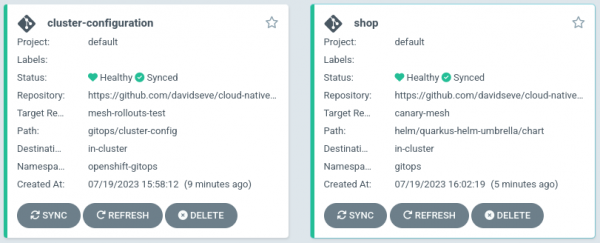
Test Shop application
We have deployed the shop with Argo CD. We can test that it is up and running.
We have to get the Online route:
curl -k "$(oc get routes products-umbrella-online -n gitops --template='https://{{.spec.host}}')/products"
And the Offline route:
curl -k "$(oc get routes products-umbrella-offline -n gitops --template='https://{{.spec.host}}')/products"
Notice that in each microservice response, we have added metadata information to see better the version of each application. This will help us to see the changes while we do the blue/green deployment. Because right now we have both routers against the same rollout revision we will have the same response with the version v1.0.1:
{
"products":[
{
...
"name":"TV 4K",
"price":"1500€"
}
],
"metadata":{
"version":"v1.0.1", <--
"colour":"none",
"mode":"online"
}
}
We can also see the rollout's status. Argo Rollouts offers a kubectl plug-in to enrich the experience with Rollouts.
kubectl argo rollouts get rollout products --watch -n gitops
NAME KIND STATUS AGE INFO
⟳ products Rollout ✔ Healthy 12m
└──# revision:1
└──⧉ products-67fc9fb79b ReplicaSet ✔ Healthy 12m stable,active
├──□ products-67fc9fb79b-49k25 Pod ✔ Running 12m ready:1/1
└──□ products-67fc9fb79b-p7jk9 Pod ✔ Running 12m ready:1/1
Products blue/green deployment
We have split a Cloud Native blue/green deployment into two steps:
- Deploy a new version.
- Promote a new version.
We have already deployed the products v1.0.1, and we are ready to use a new products v1.1.1 that has a new description attribute.
Figure 5 has the current status.

Step 1: Deploy a new version
We will deploy a new version, v1.1.1. To do it, we have to edit the file helm/quarkus-helm-umbrella/chart/values/values-rollouts-blue-green.yaml under products-blue set tag value to v.1.1.1.
products-blue:
mode: online
image:
tag: v1.1.1
And push the changes:
git add .
git commit -m "Change products version to v1.1.1"
git push origin rollouts
Argo CD will refresh the status after some minutes. If you don't want to wait you can refresh it manually from Argo CD UI or configure the Argo CD Git webhook.
Argo Rollouts will automatically deploy the new products version and execute the prePromotionAnalysis.
NAME KIND STATUS AGE INFO
⟳ products Rollout ॥ Paused 27m
├──# revision:2
│ ├──⧉ products-9dc6f576f ReplicaSet ✔ Healthy 36s preview
│ │ ├──□ products-9dc6f576f-6vqp5 Pod ✔ Running 36s ready:1/1
│ │ └──□ products-9dc6f576f-lmgd7 Pod ✔ Running 36s ready:1/1
│ └──α products-9dc6f576f-2-pre AnalysisRun ✔ Successful 31s ✔ 1
└──# revision:1
└──⧉ products-67fc9fb79b ReplicaSet ✔ Healthy 27m stable,active
├──□ products-67fc9fb79b-49k25 Pod ✔ Running 27m ready:1/1
└──□ products-67fc9fb79b-p7jk9 Pod ✔ Running 27m ready:1/1
If the prePromotionAnalysis goes well, we can see that offline applications have version v1.1.1 and the new attribute description, but the online version has not changed.
Figure 6 has the current status.
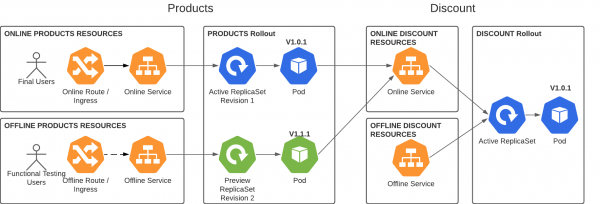
{
"products":[
{
"discountInfo":{...},
"name":"TV 4K",
"price":"1500€",
"description":"The best TV" <--
}
],
"metadata":{
"version":"v1.1.1", <--
}
}
Functional testing users can execute Smoke tests to validate this new v1.1.1 version.
Step 2: Promote a new version
We are going to open the new version to final users.
Execute this command to promote products:
kubectl argo rollouts promote products -n gitops
First, Argo Rollouts will just change the service to use the new release (ReplicaSet). We minimize downtime because it just changes the service label.
NAME KIND STATUS AGE INFO
⟳ products Rollout ✔ Healthy 88m
├──# revision:2
│ ├──⧉ products-9dc6f576f ReplicaSet ✔ Healthy 62m stable,active
│ │ ├──□ products-9dc6f576f-6vqp5 Pod ✔ Running 62m ready:1/1
│ │ └──□ products-9dc6f576f-lmgd7 Pod ✔ Running 62m ready:1/1
│ └──α products-9dc6f576f-2-pre AnalysisRun ✔ Successful 62m ✔ 1
└──# revision:1
└──⧉ products-67fc9fb79b ReplicaSet ✔ Healthy 88m delay:27s
├──□ products-67fc9fb79b-49k25 Pod ✔ Running 88m ready:1/1
└──□ products-67fc9fb79b-p7jk9 Pod ✔ Running 88m ready:1/1
Figure 7 has the current status.
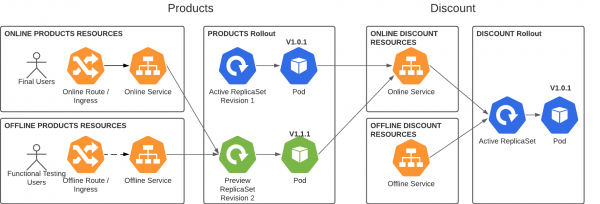
And after scaleDownDelaySeconds, Argo Rollouts will scale down the first replicaSet (v1.0.1).
NAME KIND STATUS AGE INFO
⟳ products Rollout ✔ Healthy 89m
├──# revision:2
│ ├──⧉ products-9dc6f576f ReplicaSet ✔ Healthy 62m stable,active
│ │ ├──□ products-9dc6f576f-6vqp5 Pod ✔ Running 62m ready:1/1
│ │ └──□ products-9dc6f576f-lmgd7 Pod ✔ Running 62m ready:1/1
│ └──α products-9dc6f576f-2-pre AnalysisRun ✔ Successful 62m ✔ 1
└──# revision:1
└──⧉ products-67fc9fb79b ReplicaSet • ScaledDown 89m
Figure 8 has the current status.
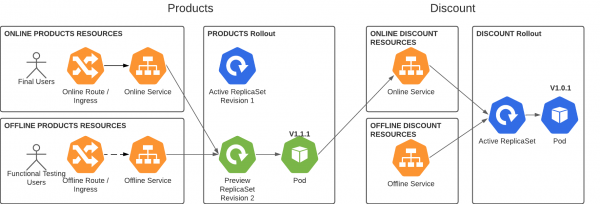
We have in the online environment the new version v1.1.1!
{
"products":[
{
"discountInfo":{...},
"name":"TV 4K",
"price":"1500€",
"description":"The best TV" <--
}
],
"metadata":{
"version":"v1.1.1", <--
}
}
Rollback
Imagine that something goes wrong—we know that this never happens, but just in case. We can do a very quick rollback just undoing the change in the Products online service.
Argo Rollouts has an undo command to do the rollback. Personally, I don't like this procedure because it is not aligned with GitOps. The changes that Argo Rollouts do does not come from Git, so Git is OutOfSync with what we have in OpenShift. In our case the commit that we have done not only changes the ReplicaSet but also the ConfigMap. The undo command only changes the ReplicaSet, so it does not work for us.
I recommend doing the changes in Git. We will revert the last commit:
git revert HEAD
git push origin rollouts
Argo CD will get the changes and apply them. Argo Rollouts will create a new revision with the previous version, Figure 9 has the Shop status.
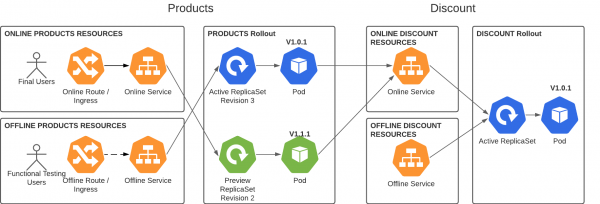
Execute this command to promote products to version v1.0.1:
kubectl argo rollouts promote products -n gitops
As you can see in Figure 10, the rollback is done!

{
"products":[
{
...
"name":"TV 4K",
"price":"1500€"
}
],
"metadata":{
"version":"v1.0.1", <--
"colour":"none",
"mode":"online"
}
}
Delete environment
To delete all the things that we have done for the demo you have to:
- In GitHub, delete the branch
rollouts. - In Argo CD, delete the application
cluster-configurationandshop. - In OpenShift, go to project
openshift-operatorsand delete the installed operators Openshift GitOps.
